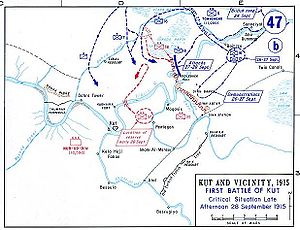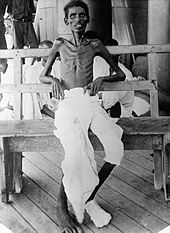Siege of Kut - Picture
More about World War 1

|
|
Siege of Kut
Date: Date
December 7, 1915 - April 29, 1916
Location
Kut-al-Amara
(in Iraq)
Result
Decisive Ottoman victory
Date: December 7, 1915 - April 29, 1916
Location: Kut-al-Amara
(in Iraq)
Result: Decisive Ottoman victory
Belligerents:
: United Kingdom
British India
Commanders and leaders:
: Charles Townshend (P.O.W.)
Strength:
: 31,000
Casualties and losses:
: 30,000 dead or wounded
13,000 captured
British India
The siege of Kut Al Amara (7 December 1915 - 29 April 1916), was the besieging of 8,000 British and Indian soldiers in the small town of Kut, 100 miles south of Baghdad, by the Turkish army. Its known also as 1st Battle of Kut. In 1915, its population was around 6,500. Following the surrender of the British-Indian garrison on April 29, 1916, the survivors of the siege were marched to imprisonment at Aleppo.
Prelude

Picture - Situation at Kut on 28 September 1915.
The 6th (Poona) Division of the Indian Army, under Major-General Charles Townshend, had fallen back to the town of Kut after retreating from Ctesiphon. The British Empire forces arrived at Kut around 3 December 1915. They had suffered significant losses and were down to around 11,000 soldiers (plus cavalry). General Townshend chose to stay and hold the position at Kut instead of continuing the march downriver towards Basra. Kut offered a good defensive position because it was contained within a long loop of the river. The problem was how to get supplies, since Kut was a long way from Basra.
The siege
The pursuing Ottoman forces arrived on 7 December 1915. Once it became clear the Ottomans had enough forces to lay siege to Kut, Townshend ordered his cavalry to escape south, which it did, led by Lieut. Colonel Gerard Leachman DSO. The Ottoman forces numbered around 11,000 men and were commanded by the respected but old German General and military historian Baron von der Goltz. Goltz knew the Ottoman army well, as he had spent 12 years working on modernizing the Ottoman army from 1883 to 1895. After three attacks in December, Goltz directed the building of siege fortifications facing Kut. He also, like Caesar at the Alesia, prepared for an attack from Basra, using the Tigris River, by building defensive positions further down the river.
After a month of siege, Townshend wanted to break out and withdraw southwards but his commander, Sir John Nixon saw value in tying down the Ottoman forces in a siege. However, when Townshend - inaccurately - reported only one month of food remained, a rescue force was hastily raised. It is not clear why Townshend reported he only had enough food for one month when he actually had food for more than four months (although at a reduced level).
Relief expeditions
The first relief expedition comprised some 19,000 men under General Aylmer and it headed up the river from Ali Gharbi in January 1916.
Battle of Sheikh Sa'ad
The first attempt to relieve Kut (the Battle of Sheikh Sa'ad) came on 6 January. Aylmer's advance force, under Major-General Younghusband, moved forward from Ali Al Gharbi towards Sheikh Sa'ad along both banks of the Tigris. Younghusband's column made contact with the Ottomans on the morning of 6 January 3.5 miles east of Sheikh Sa'ad. British efforts to defeat the Ottomans were unsuccessful.[1]
The following day, on 7 January, Aylmer arrived with the main body of his forces and ordered a general attack. Younghusband led the attack on the left bank and Major-General Kemball took the right. After heavy fighting all day, Kemball's troops had overrun Ottoman trenches on the right bank, taking prisoners and capturing two guns. However, the Ottoman left bank held firm and the Ottomans carried out supporting manoeuvres from the north.
After little change on 8 January, renewed British attacks on 9 January resulted in the Ottomans retiring from Sheikh Sa'ad. Over the following two days the Ottomans were followed by Aylmer's force but heavy rains made the roads virtually impassable.[2]
Battle of Wadi
The Ottomans retreated for about ten miles (16 km) from Sheikh Sa'ad to a tributary of the Tigris on the left bank known by the Arabic toponym simply as the Wadi (meaning "the river valley"). The Ottomans made their camp beyond the Wadi and on the other side of the Tigris opposite the Wadi.
On 13 January, Aylmer attacked the Ottoman Wadi position on the left bank with all of his forces. After putting up a stiff resistance the Ottomans retreated five miles (8 km) to the west and they were followed by Aylmer's troops.
Battle of Hanna
The Ottomans then made their camp upstream of the Wadi at the Hanna defile, a narrow strip of dry land between the Tigris and the Suwaikiya Marshes. British losses at the Battle of Hanna amounted to 2,700 killed and wounded which was disastrous for the garrison in Kut.[3]
Later efforts
At this point, Khalil Pasha (the Ottoman commander of the whole region) came to the battle, bringing with him a further 20,000 to 30,000 reinforcements.
Following the defeat of Aylmer's expedition, General Nixon was replaced as supreme commander by Percy Lake. More forces were sent to bolster Aylmer's troops. He tried again, attacking the Dujaila redoubt on 8 March. This attack failed, at a cost of 4,000 men. General Aylmer was dismissed and replaced with General George Gorringe on 12 March.
The relief attempt by Gorringe is usually termed the First Battle of Kut. The British Empire's forces numbered about 30,000 soldiers, roughly equal to the Ottomans. The battle began on 5 April and the British soon captured Fallahiyeh, but with heavy losses, Bait Asia was taken on 17 April. The final effort was against Sannaiyat on 22 April. The Allies were unable to take Sannaiyat and suffered some 1,200 casualties in the process.
All the relief efforts had failed, at a cost of around 23,000 Allied killed or wounded. Ottoman casualties are believed to have been around 10,000. The Ottomans also lost the aid of Baron von der Goltz. He died on 19 April, supposedly of typhoid. After Goltz's death, no German commander took his place in Mesopotamia for the rest of the war.
Surrender of the British army

Picture - An Indian soldier after siege of Kut
British leaders attempted to buy their troops out. Aubrey Herbert and T. E. Lawrence were part of a team of officers sent to negotiate a secret deal with the Ottomans. The British offered Ł2 million and promised they would not fight the Ottomans again, in exchange for Townshend's troops. Enver Pasha ordered that this offer be rejected.
The British also asked for help from the Russians. General Baratov, with his largely Cossack force of 20,000 was in Persia at the time. Following the request he advanced towards Baghdad in April 1916 but turned back when news reached him of the surrender.
General Townshend arranged a ceasefire on the 26th and, after failed negotiations, he simply surrendered on 29 April 1916 after a siege of 147 days. Around 13,000 Allied soldiers survived to be made prisoners. 70% of the British and 50% of the Indian troops died of disease or at the hands of the Ottoman guards during captivity. Townshend himself was taken to the island of Halki on the Sea of Marmara, to sit out the war in luxury.
In British Army battle honours, the siege of Kut is named as "Defence of Kut Al Amara".
Aftermath
James Morris, a British historian, described the loss of Kut as "the most abject capitulation in Britain’s military history." After this humiliating loss, General Lake and General Gorringe were removed from command. The new commander was General Maude, who trained and organized his army and then launched a successful campaign which captured Baghdad on 11 March 1917. With Baghdad captured, the British administration undertook vital reconstruction of the war-torn country and Kut was slowly rebuilt.
Some of the Indian prisoners of war from Kut later came to join the Ottoman Indian Volunteer Corps under the influence of Deobandis of Tehrek e Reshmi Rumal and with the encouragement of the German High Command. These soldiers, along with those recruited from the prisoners from the European Battlefields fought alongside Ottoman forces in a number of fronts. The Indians were led by Amba Prasad Sufi, who during the war was joined by Kedar Nath Sondhi, Rishikesh Letha and Amin Chaudhry. These Indian troops were involved in the capture of the frontier city of Karman and the detention of the British consul there, and also successfully harassed Sir Percy Sykes' Persian campaign against the Baluchi and Persian tribal chiefs who were aided by the Germans.
Sources
Herbert, Edwin (2003), Small Wars and Skirmishes 1902-1918: Early Twentieth-century Colonial Campaigns in Africa, Asia and the Americas, Nottingham, Foundry Books Publications
Qureshi, M Naeem (1999), Pan-Islam in British Indian Politics: A Study of the Khilafat Movement, 1918-1924., Brill Academic Publishers, ISBN 9004113711
Sykes, Peter (1921), South Persia and the Great War. The Geographical Journal, Vol. 58, No. 2 (August 1921), pp. 101-116, Blackwell Publishing on behalf of The Royal Geographical Society, ISSN: 00167398
Further reading
Barber, Major Charles H. Besieged in Kut - and After Blackwood, 1917
Braddon, Russell The Siege Cape, 1969 / Viking Adult, 1970 ISBN 0-670-64386-6
Dixon, Dr. Norman F. On the Psychology of Military Incompetence Jonathan Cape Ltd 1976 / Pimlico 1994 pp95-109
Gardiner, Nikolas. 2004. 'Sepoys and the Siege of Kut-al-Amara, December 1915-April 1961', War in History, 11(3): pp. 307-326. (journal article)
Harvey, Lt & Q-Mr. F. A. The Sufferings of the Kut Garrison During Their March Into Turkey as Prisoners of War 1916-1917 Ludgershall, Wilts: The Adjutants's Press, 1922
Keegan, John (1998). The First World War. Random House Press.
Long, P. W. Other Ranks of Kut Williams & Norgate, 1938
Mouseley, Capt. E. O. The Secrets of a Kuttite: An Authentic Story of Kut, Adventures in Captivity & Stamboul Intrigue Bodley Head, 1921
Sandes, Major E. W. C. In Kut & Captivity with the Sixth Indian Division Murray, 1919
Strachan, Hew (2003). The First World War, pp 125. Viking (published by the Penguin Group).
Wilcox, Ron (2006) Battles on the Tigris. Pen and Sword Military.
Mons, Anzac & Kut by Aubrey Herbert
More aircraft.
Source: WikiPedia